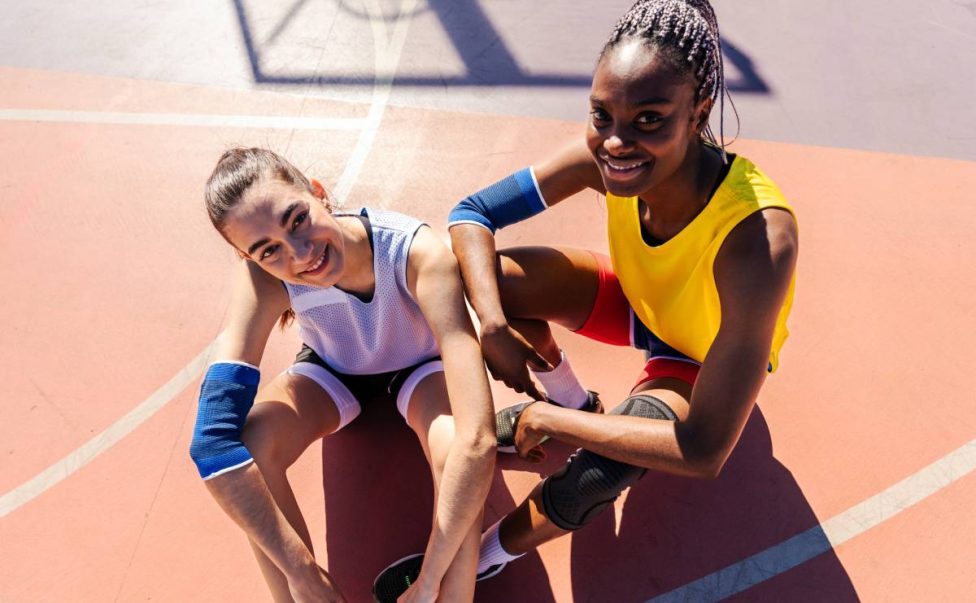Protecting the Unspoken: How Female Athletes Prevent Injuries
Sports are synonymous with physical skill, competition, and victory, but they also carry risks and injuries.
While common injuries like sprains and concussions are well-known, breast-related injuries often go unnoticed, especially among female athletes.
These injuries can significantly affect performance and well-being. From football’s high-impact nature to basketball’s fast-paced collisions, female athletes face unique challenges in protecting their breasts during competition.
This article explores common injuries in women’s sports and how female footballers and basketball players safeguard their breasts to stay competitive.
The Most Common Injury in Women’s Sports
Women athletes commonly face injuries to joints, tendons, and ligaments, with knee injuries, particularly ACL tears, being the most prevalent. ACL injuries are more common in women due to anatomical and biomechanical factors like wider hips and hormonal differences.
In addition to knee injuries, female athletes in sports like soccer, basketball, and tennis often experience ankle sprains, shoulder injuries, and stress fractures, all of which can severely impact performance. However, breast-related injuries, though specific to female athletes, are often overlooked despite their potential impact on performance.
How Do Female Footballers Protect Their Breasts?
Football is a physically demanding sport that involves frequent contact, running, and abrupt movements. For female football players, the risk of breast injury comes from both the impact of the sport and the repetitive jarring motions that occur during gameplay.
Female athletes, due to their breast tissue, are more vulnerable to injury compared to their male counterparts. While the injury rates in football for females may not be as high as knee or ankle injuries, breast-related trauma can still occur, particularly when athletes experience falls, tackles, or collisions with other players.
Sports Bras:
A high-quality sports bra is the first line of defense for any female athlete, and footballers are no exception. The primary function of a sports bra is to minimize breast movement during physical activity.
This is crucial for reducing the potential for trauma, as excessive movement can lead to ligament damage or strain.
Many footballers wear compression sports bras or high-support sports bras that provide ample support to keep the breasts in place and reduce the risk of injury. T
he right fit is essential too tight, and it can cause discomfort or restrict movement; too loose, and it won’t offer enough support.
Chest Protectors:
In some instances, particularly for women playing at a professional or elite level, additional protection in the form of chest guards or padded vests may be worn.
These protective garments are designed to shield the chest area from direct impact, reducing the chance of bruising, contusions, or even more severe injuries like rib fractures.
Though not as common as sports bras, chest protectors can be useful in reducing the risk of injury, especially when players are involved in frequent physical confrontations or aerial duels.
How Do Female Basketball Players Protect Their Breasts?
Basketball, like football, is a high-contact sport where players are constantly moving, jumping, and being jostled.
Female basketball players are at risk of breast injuries due to the constant impact and the nature of the sport, which includes collisions with opponents, frequent landing after jumps, and rapid directional changes.
Sports Bras:
A well-fitted, high-support sports bra is crucial for female basketball players, as the sport involves intense movements like sprinting, jumping, and sudden stops that can cause breast movement.
A good sports bra minimizes this movement, reducing strain on the breast tissue and ligaments.
Many players choose bras with adjustable straps, wide bands, and compression features for stability. Those with larger busts may opt for full-coverage bras or high-performance fabrics that wick away sweat and enhance comfort during play.
Protective Gear:
While not as commonly used as sports bras, some female basketball players may choose to wear additional protective gear, such as padded tops or vests.
These padded garments provide extra protection to the chest area during physical contact, such as when a player is boxed out under the basket or involved in a collision while trying to gain possession of the ball. The padding helps absorb some of the impact and reduces the risk of bruising or injury.
Other Ways Female Athletes Protect Their Breasts
While sports bras and padded garments are the primary forms of breast protection, there are other strategies that female athletes use to prevent injury:
- Proper Warm-up and Stretching: A proper warm-up before any physical activity is essential for minimizing the risk of injury. This includes dynamic stretching to loosen muscles and ligaments, which can help prevent strains and sprains in the chest area. Female athletes often perform exercises that specifically target the upper body, ensuring that the muscles around the chest and shoulders are prepared for the physical demands of their sport.
- Strengthening Exercises: Strength training is important for female athletes to enhance overall performance and prevent injuries. By strengthening the muscles around the chest, shoulders, and back, athletes can improve their posture and reduce the risk of strains or sprains. Strengthening the core also plays a significant role, as a strong core can help athletes maintain balance and reduce the likelihood of falls or awkward landings that could lead to breast injury.
- Recovery and Rest: Injury prevention is not only about what athletes do during the game or training but also about how they recover afterward. Adequate rest, hydration, and nutrition are critical components in preventing injuries. Female athletes should also incorporate recovery strategies like foam rolling or massage to reduce muscle tightness that could contribute to injury.
- Chronic pain can be an issue for some female athletes, especially if they have experienced repetitive injuries or trauma to the breast area. The constant impact and jarring movements can contribute to the development of chronic pain in the chest, shoulders, or upper back. In such cases, athletes may need to consult with healthcare professionals for advice on managing pain through proper treatment, which may include physical therapy, rest, and pain management techniques. Addressing chronic pain early on and incorporating pain-relief strategies into an athlete’s routine is essential for maintaining long-term performance.
Conclusion
Breast-related injuries are an important concern for female athletes, especially in contact sports like football and basketball. While these injuries are not as frequently discussed as knee or ankle injuries, they can still cause significant discomfort and impact an athlete’s performance.
Sports bras and padded garments are the primary forms of protection for female athletes, but other strategies such as strength training, proper warm-up routines, and recovery practices also play crucial roles in minimizing the risk of injury.
By understanding the potential for breast injuries in sports and taking steps to protect this vulnerable area, female athletes can continue to compete at the highest levels while ensuring their health and safety.
As awareness grows, it is likely that more innovative protective gear will emerge to address these concerns, ensuring that female athletes can play with confidence and without the worry of unnecessary injury.


